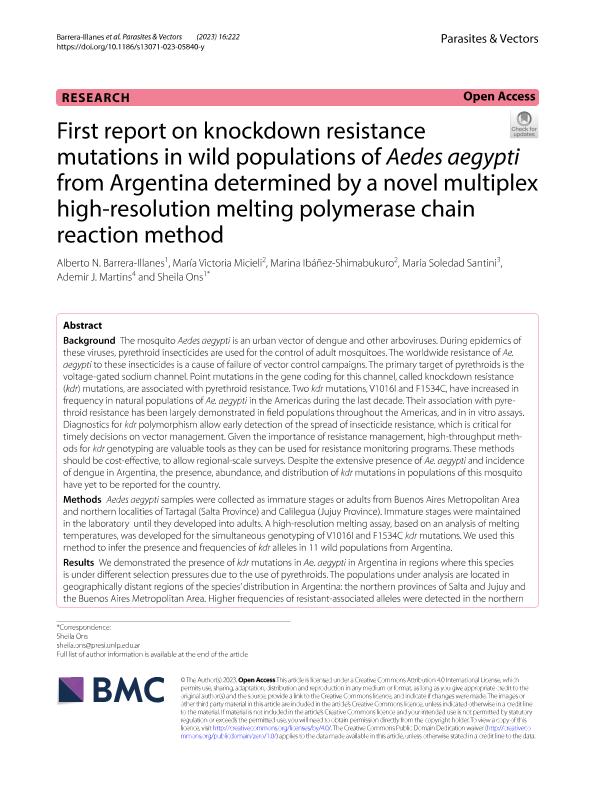Artículo
First report on knockdown resistance mutations in wild populations of Aedes aegypti from Argentina determined by a novel multiplex high-resolution melting polymerase chain reaction method
Barrera Illanes, Alberto Nicolás ; Micieli, Maria Victoria
; Micieli, Maria Victoria ; Ibáñez, Marina
; Ibáñez, Marina ; Santini, Maria Soledad
; Santini, Maria Soledad ; Martins, Ademir J.; Ons, Sheila
; Martins, Ademir J.; Ons, Sheila
 ; Micieli, Maria Victoria
; Micieli, Maria Victoria ; Ibáñez, Marina
; Ibáñez, Marina ; Santini, Maria Soledad
; Santini, Maria Soledad ; Martins, Ademir J.; Ons, Sheila
; Martins, Ademir J.; Ons, Sheila
Fecha de publicación:
12/2023
Editorial:
BioMed Central
Revista:
Parasites and Vectors
ISSN:
1756-3305
Idioma:
Inglés
Tipo de recurso:
Artículo publicado
Clasificación temática:
Resumen
Background: The mosquito Aedes aegypti is an urban vector of dengue and other arboviruses. During epidemics of these viruses, pyrethroid insecticides are used for the control of adult mosquitoes. The worldwide resistance of Ae. aegypti to these insecticides is a cause of failure of vector control campaigns. The primary target of pyrethroids is the voltage-gated sodium channel. Point mutations in the gene coding for this channel, called knockdown resistance (kdr) mutations, are associated with pyrethroid resistance. Two kdr mutations, V1016I and F1534C, have increased in frequency in natural populations of Ae. aegypti in the Americas during the last decade. Their association with pyrethroid resistance has been largely demonstrated in field populations throughout the Americas, and in in vitro assays. Diagnostics for kdr polymorphism allow early detection of the spread of insecticide resistance, which is critical for timely decisions on vector management. Given the importance of resistance management, high-throughput methods for kdr genotyping are valuable tools as they can be used for resistance monitoring programs. These methods should be cost-effective, to allow regional-scale surveys. Despite the extensive presence of Ae. aegypti and incidence of dengue in Argentina, the presence, abundance, and distribution of kdr mutations in populations of this mosquito have yet to be reported for the country. Methods: Aedes aegypti samples were collected as immature stages or adults from Buenos Aires Metropolitan Area and northern localities of Tartagal (Salta Province) and Calilegua (Jujuy Province). Immature stages were maintained in the laboratory until they developed into adults. A high-resolution melting assay, based on an analysis of melting temperatures, was developed for the simultaneous genotyping of V1016I and F1534C kdr mutations. We used this method to infer the presence and frequencies of kdr alleles in 11 wild populations from Argentina. Results: We demonstrated the presence of kdr mutations in Ae. aegypti in Argentina in regions where this species is under different selection pressures due to the use of pyrethroids. The populations under analysis are located in geographically distant regions of the species’ distribution in Argentina: the northern provinces of Salta and Jujuy and the Buenos Aires Metropolitan Area. Higher frequencies of resistant-associated alleles were detected in the northern region. We report a multiplex high-throughput assay based on a high-resolution melting polymerase chain reaction method for the simultaneous genotyping of V1016I and F1534C kdr mutations. This assay was shown to be cost-effective, and thus provides an interesting molecular tool for kdr genotyping in A. aegypti control campaigns. Conclusions: We report, to the best of our knowledge for the first time, the presence of kdr mutations in populations of Ae. aegypti from geographically distant locations of Argentina that differ with respect to their epidemiological situation and history of mosquito control. We have developed a high-throughput method for the genotyping of kdr mutations in Ae. aegypti from the Americas. Given its affordability and short running time, this method can be used in control campaigns to monitor the presence and spread of kdr alleles. The information provided here is relevant for the rational design of control strategies in the context of integrated vector management.
Palabras clave:
ARBOVIRUS
,
DENGUE
,
INSECTICIDE
,
MOSQUITO
,
PYRETHROID RESISTANCE
,
VECTOR MANAGEMENT
Archivos asociados
Licencia
Identificadores
Colecciones
Articulos(CENEXA)
Articulos de CENTRO DE ENDOCRINOLOGIA EXP.Y APLICADA (I)
Articulos de CENTRO DE ENDOCRINOLOGIA EXP.Y APLICADA (I)
Articulos(CEPAVE)
Articulos de CENTRO DE EST.PARASITOL.Y DE VECTORES (I)
Articulos de CENTRO DE EST.PARASITOL.Y DE VECTORES (I)
Articulos(SEDE CENTRAL)
Articulos de SEDE CENTRAL
Articulos de SEDE CENTRAL
Citación
Barrera Illanes, Alberto Nicolás; Micieli, Maria Victoria; Ibáñez, Marina; Santini, Maria Soledad; Martins, Ademir J.; et al.; First report on knockdown resistance mutations in wild populations of Aedes aegypti from Argentina determined by a novel multiplex high-resolution melting polymerase chain reaction method; BioMed Central; Parasites and Vectors; 16; 1; 12-2023; 1-11
Compartir
Altmétricas



